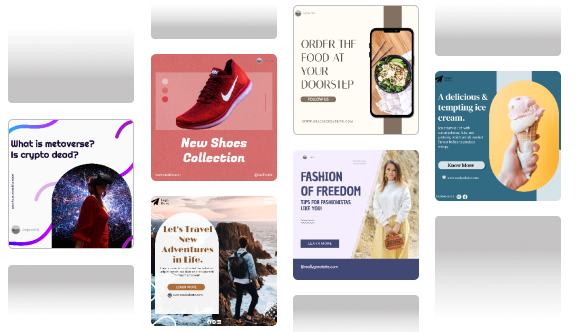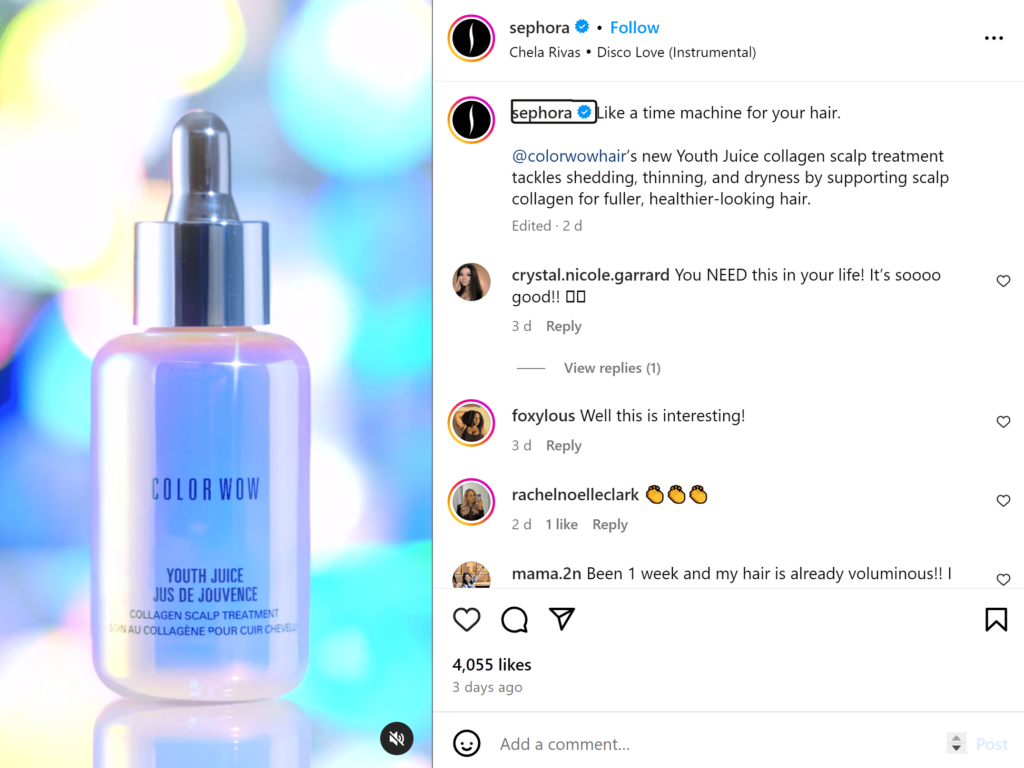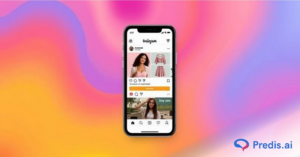Are you finding it difficult to capture attention in the bustling online marketplace? For businesses seeking to increase visibility and sales, social media advertising has emerged as one of the most critical means. All in all, more than 5 billion people are active on social media sites around the world, with almost 6 billion projected to be active by 2028. The potential for both reach and engagement is enormous.
When you make a social media ad for a product, it’s crucial that it catches the eye and also involves strategic content that speaks directly to your audience. Effective social media advertisements have a clear and appealing message, visuals, and a persuasive call to action that directs potential customers toward making a purchase. These combined elements make your simple product advertisement a powerhouse for customer engagement and conversion. Ready to learn how to make a social media ad for a product that stands out? Let’s dive into the basics of creating ads that get seen and truly make an impact.
Setting Clear Objectives for Your Ad
Setting clear objectives for your social media ads is the cornerstone of successful digital marketing. Clear goals guide your campaign direction and help you measure its success effectively. Defining precise objectives is crucial to achieving this outcome, whether you aim to enhance brand awareness, increase engagement, or drive conversions.
1. Defining Marketing Goals
Begin by identifying the specific purpose of your ad. Common goals include increasing brand awareness, which would involve creating ads that reach a wide audience and highlight the unique values of your brand. If the objective is sales conversion, the focus should be on showcasing specific products, integrating strong calls-to-action, and targeting an audience likely to purchase based on previous interactions.
2. Aligning Ad Objectives with Business Goals
Ensuring that your advertising objectives align with broader business goals is vital. Misalignment can lead to inefficient resource use and diluted campaign messages. For instance, if expanding into new market segments is a strategic goal, your ads should be customized to introduce and establish your brand within these markets effectively.
3. Importance of Specific Objectives
Specific and measurable objectives have a higher chance of success. Such clearly defined goals facilitate targeting efforts, optimizing the message, and maximizing the cost-effectiveness of ad expenditures. This way, ROI will be maximized for every dollar spent.
Understanding Your Target Audience
Understanding your target audience is fundamental to creating effective social media ads for your product. This involves meticulously profiling the demographic most likely to engage with and purchase your product, ensuring that your marketing efforts are impactful.
Steps to Identify and Profile Your Target Demographic
- Gather Information: Use social media analytics, customer feedback, and website traffic data to get the most important demographic information. Utilize tools such as Google Analytics or Facebook Insights to understand your audience’s age, gender, geographical location, and interests.
- Create Buyer Personas: Based on your data collection, develop in-depth buyer personas. These should outline people’s demographic information, purchasing behaviors, preferences, and pain points. For instance, a buyer persona for an online shop that sells fitness equipment could be someone in his thirties who is health-conscious and looking for quick solutions for working out at home.
- Segment Your Audience: Divide your wider audience into manageable groups with shared characteristics. This divides the large audience into particular segments with customized content and, consequently, makes sending relevant messages possible. A message tailored to every group can increase the performance of your ad campaigns.
How Audience Insights Influence Ads Design and Messaging
- Personalization in visuals and content: Visual tastes can be quite different across certain demographics. Younger audiences might have a more natural liking to trendy and dynamic visuals, while older segments tend toward traditional and text-heavy layouts.
- Personalized Messaging: Knowing what drives your audience permits you to create deep resonance with your messaging. So, if a particular segment is driven by eco-consciousness, then emphasizing the sustainability of your products might be a winning strategy.
Effective product social media marketing begins with a deep understanding of the audience, which can significantly change the course of your ad campaigns. A study from McKinsey shows that 71% of consumers want companies to deliver personalized interactions, while 76% get frustrated when this doesn’t happen. Understanding who your ads speak to enhances their relevance and improves ROI.
Crafting a Compelling Ad Message
To stand out, your ads must have a message that will be noticed and felt by an audience. A strong ad message could actually be the difference between just another ignored ad and an ad that drives interest and action. Here are a few tips for creating an effective ad message:
- Start with a Strong Hook: Your opening statement should be attention-grabbing. That can be with compelling words, asking a question that solves common problems, or satisfying the needs of your product.
- Use Layman’s Terms: Communicate in a manner that is easy for your audience to understand and relate to. Avoid using jargon unless your audience is familiar with it.
- Create a Memorable Tagline: Creating a memorable tagline will give you an assurance of the brand identity and increase its recall value. This should be short, clear, and coherent with the main core message of the ad.

Need quick, creative posts for your campaign? Use Predis.AI’s Social Media Post Generator to produce high-quality content tailored to your brand and audience.
The Importance of Message Consistency
Make the message consistent across a variety of social platforms. This further solidifies brand recognition and increases trust within your audience. If the message is too inconsistent from one platform to the other, it might confuse potential customers and dilute the power of your campaign.
- Coordinate Your Campaigns: Ensure that all elements of your campaigns are harmonized across platforms. This includes visuals, tone of voice, and core messages.
- Tailor Without Altering: While it’s important to tailor your message to fit different platform norms and audience preferences, the underlying message should remain consistent.
According to a report by Lucidpress, brand consistency can increase revenues by up to 23% across all platforms. A good example is Nike’s “Just Do It” slogan; literally, the slogan is everywhere and has delivered the message of empowerment and perseverance through athletic endeavors.
Designing Your Social Media Ad
It’s about infusing art with strategy as you design product ads for social media that catch the eye and incite action. The following are some key principles for designing social media ads that pop within the digital landscape:
- Visual Hierarchy: Essential in designing product ads, this is the arrangement of elements in an ad so that it creates a clear sense of order. Begin by letting the eye see the most important element: the product or major message. Establish the focus on this by size, color, and placement.
- Simplify: An overcomplicated design may confuse or overwhelm the viewer. Keep it simple, and make sure the message is clear and attractive with a clean layout and minimal text.
- Brand Consistency: Ensure your ad reflects the brand consistently through colors, fonts, and style. It should maintain brand recognition and build trust.
- Use of Colors: Colors can evoke emotions and actions. Make sure that the color aligns with the emotion you are looking to create. For instance, red can create urgency, while blue can create trust.
- Engaging Imagery: Make sure your images are high-quality and directly display your product or apply to your message. They should be contextually relevant and high resolution to catch the eye in a sea of content.
Utilizing Product Ad Templates Effectively
Product ad templates are a great starting point, especially if you are new to designing ads or are short on time. Here’s how to use a product ad template:
- Select the Right Template: Choose a template that best suits your campaign’s tone and its purpose. The campaign message, whether promotional, informative, or inspirational, should be well supported by the use of the chosen template.
- Thoughtfully Customize: While templates give a general idea, the crucial aspect is being able to customize them. Adapt the template to incorporate your brand’s colors, fonts, and style. Modify elements to showcase your product in a unique way.
- Focus on the Copy: Even the best-designed ad can fail if the copy isn’t great. Custom-tailor your message to speak directly to your audience’s needs and desires. Keep it short and to the point but action-driven.
- Test and Optimize: A/B tests your ad with different versions to know what works best in terms of design and messaging.
Ready to create stunning visual ads? Use Predis.AI’s E-commerce Social Media Post Maker to bring your product to life on social media effortlessly.
Choosing the Right Visuals
Choosing the right visuals is critical in product ad design, as it can significantly influence the success of your social media advertisements. The effectiveness of a well-chosen picture or video lies in its ability to grab attention and accurately represent the product, creating a strong first impression that can lead to customer conversion.
Guidelines for Selecting Impactful Visuals
- Relevance is Key: The visuals must be directly related to the product or message. For example, if promoting fitness gear, feature images or videos that show people actively using your products during their workouts. This displays the product and also contextualizes it, which enhances the viewer’s connection.
- Uncompromised Quality: Poor quality visuals may hurt your brand perception and diminish the impact of your advertisement. Ensure that your visuals appear professional and are well-illuminated to hold viewer interest.
- Emotionally Engaging: Use visuals that will create an emotional connection with your ad message. For instance, warm and positive visuals are very appropriate for promoting products intended to create pleasurable and good feelings.
Significance of Visual Elements in Enhancing Appeal of Advertisement
Visuals decorate, convey your message, and enhance the appeal of your ad. They can express ideas and emotions easily, making your ad approachable and easy to read. This becomes all the more crucial in today’s cluttered social media landscape, where you get attention at a single glance.
Bring your products to life with dynamic video ads. Try Predis.AI’s E-commerce Video Maker to easily create videos that capture your audience’s attention and boost engagement.
Writing Engaging Ad Copy
The right words can motivate viewers to act, enhancing the impact of the visuals and driving conversions. Here are some best practices for writing concise, persuasive copy that resonates with your audience:
- Keep It Clear and Concise: Social media users scroll quickly, so your message needs to be understood at a glance. Use simple, direct language that communicates your message quickly and clearly. Avoid jargon and overly complex phrases.
- Benefit Focused: Focus on what a product does instead of what the product is. Your target audience should know what problem you are solving and how your product will improve their lives. For instance, use “Experience natural rejuvenation with every use” instead of “Made with natural ingredients.”
- Strong Call to Action: A strong ad copy must contain a powerful CTA that leads readers towards performing a particular action. Use action-oriented language like ‘Buy now’, ‘Join us’, or ‘Get yours today’. All of these will greatly lift the possibility of converting.
- Use Emotional Triggers: Emotions drive behavior. Design your copy such that it speaks to certain emotions like happiness, relief, or excitement that you expect out of your product. For example, an ad for a vacation booking service could be “Escape to paradise and leave your worries behind!” This is the way you want customers to feel.
- Test and Optimize: Test different versions of your ad copy regularly to check which one resonates best with your audience. Use A/B testing to compare different messages and refine them based on the results.
Examples of Effective Copywriting in Product Ads
- Nike: “Just Do It” is simple, motivational, and understood all over the world.
- L’Oréal: “Because You’re Worth It” speaks to self-esteem and personal value, urging the consumer to treat themselves to their brand’s products because they deserve the best.
Struggle with words? Let Predis.AI’s Social Media Ad Copy Generator help you create engaging text that converts.
Choosing the Right Social Media Platform

With the right choice of social media platform for your product social media marketing, you will be able to maximize the effect of your advertising efforts. Each platform has unique features and demographics, so targeting your ads should be very specific:
- Facebook: Probably the most demographic-diverse platform, Facebook allows specific targeting based on interests, behavior, and demographics. It is particularly useful to generate brand awareness and convert people. It has a considerable number of options for ad formats such as images, videos, carousels, and more.
- Instagram: This is a visual-focused platform that works best with products requiring a strong visual element, like fashion, beauty, and lifestyle goods. Its audience primarily consists of Millennials and Gen Z, which makes it an ideal choice for brands targeting these younger demographics.
- Pinterest: Does really well for items that are more DIY, home decor, food-related, and craft-based. The user base is largely female, and the platform is close to a visual search engine. This makes it perfect for brands with inspiration-driven purchases and whose products are beautiful in appearance.
- Twitter: Owing to its fast nature and text-constrained approach, Twitter is apt for current product promotions and brand announcements. Its ad structure and form allow for easily delivered messages and reaching those audiences that show interest in events and trends.
- LinkedIn: This is right for selling B2B products and services since this platform has an educated environment. On LinkedIn, one is able to target professionals and decision-makers. Hence, it is good for high-priced products or services that demand thought in investment.
Criteria for Choosing the Best Platform
- Audience Match: Make sure to use the platform where your target demographic spends their time most. For example, if you’re targeting young adults, consider Instagram.
- Ad Format Compatibility: Align your product’s needs with the ad formats available on the platform. For visually compelling products, platforms like Instagram or Pinterest would be advantageous.
- Budget Considerations: Advertising on each platform has a different cost. Consider the budget when compared with the typical return on investment within the platform. Facebook and Instagram can be potential platforms with high returns due to their large database and advanced targeting.
- Engagement: Applications featuring stories, live videos, and other interactive elements generally achieve higher engagement rates. Therefore, platforms like Instagram and Facebook are particularly effective for campaigns aimed at boosting engagement.
According to global research taking place from January 2020 to December 2022, TikTok has the highest engagement rate per post compared to Instagram, Facebook, and X (formerly known as Twitter).
According to Statista 2022, TikTok’s average engagement rate per post came to 4.25 percent. The average rate per post on Instagram in 2022 was 0.6 percent, and Facebook was at 0.15 percent. Product-based companies that are very visual are best able to capitalize on the image and video-centric feed of Instagram.
Plan and schedule your social media ads like a pro with Predis.Ai’s Social Media Content Calendar. Stay organized, and never miss an optimal posting time!
Testing and Optimizing the Ad
Testing and optimizing your social media ads is essential for maximizing their effectiveness and ensuring your advertising budget is well-spent. A/B testing, also known as split testing, can really help an individual find what strategies work best with their social media campaigns.
Social Media Advertisement A/B Testing Approaches
- Variable Selection: Begin by choosing just one piece of the test element at a time, such as the headline, image, CTA, or ad copy. This will help you clearly understand what changes drive performance.
- Create Variants: Produce two versions of the ad, one containing the original element and another using the changed element. For example, if you’re testing the image, one ad will have a product image, while in the other, you’d swap out the product image with a lifestyle image that displayed what the product looked like in action.
- Target Audience: To maintain integrity, make sure the two different versions of the ad are shown to audiences of similar makeup. Most paid social media platforms have native functionality built in to randomize the audience exposed to different versions of your ads.
- Performance Monitoring: Use the platform’s performance metrics, such as engagements, click-through rates, and conversions, to monitor each ad’s performance.
Conclusion
Creating impactful social media ads requires a deep understanding of your audience, strategic messaging, engaging visuals, and continuous optimization. Remember, the goal is not just to attract eyes but to engage hearts and minds, prompting action towards your products. Test everything with A/B tests to optimize every component of your ads.
Ready to take your social media advertising to the next level? Experiment with these proven strategies and utilize Predis.ai tools to streamline your ad creation process. Start now by exploring our comprehensive suite of tools designed to help you craft, test, and optimize your ads efficiently. Start your free trial today!

















